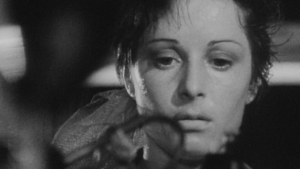A few columns back, I wrote about Ritz Cinemas and its retro and specialist programming. Since then, the Sydney theatre has run an extraordinarily ambitious program spanning July to October 2022: titled ‘85 Films in 85 Days’,it featured one film per night from each year since the Ritz began trading, beginning with 1937’s A Star Is Born (William A Wellman) and culminating with 2021’s The Green Knight (David Lowery).
I was enormously excited by the announcement of this program; impressed at the scale, ambition and bravery of it; and, frankly, not a little nervous for the effect it might have on the Art Deco theatre’s bottom line. If the program was a fizzer, they’d committed to eighty-five films, dwarfing even their recent chronological career retrospective of the work of Spanish auteur Pedro Almodóvar – which, at twenty-two feature films, seemed as big as a program like this could get.
As it turns out, not only did I – and the Ritz – not need to worry, they (and cinema lovers all over Sydney) had reason to cheer. The success of the program took even the management by surprise, as Benji Tamir, programming manager for the Ritz and its sister cinemas in Melbourne, recounts:
We knew this was a good idea from the beginning, but we also knew it was a huge risk. We expected the weekend sessions to take off along with the big, well-known films. What we didn’t expect was that people [would come] out on a Monday night in the hundreds.
Hundreds, indeed – and, over eighty-five nights, the total tickets sold for the program ended up being well over 10,000. The average attendance for the season ended up being 200 per screening, justifying the decision to screen almost all of the series’ eighty-five films in the Ritz’s largest – and original – auditorium, Cinema 1, which has a 675-seat capacity. Stanley Kubrick’s 2001: A Space Odyssey (1968) filled every one of those. The films selected were all already, in one way or another, ‘classics’, with strong name recognition, critical appreciation and followings – mainstream, cult or otherwise – but nevertheless, these screenings seemed to strike some kind of nerve. Whether it was down to the post-COVID communal opportunity to get out with others or just word of mouth, the series both exceeded expectations and became something far more significant than traditional retro programming.
I attended thirteen of the screenings, and was struck on each occasion by their buoyant energy. The audience was, to my mind, surprisingly young; I felt that the majority were in their twenties, in many cases assuredly seeing these films for the first time on the big screen (and even, possibly, for the first time in any format). Many were in groups of three or more and, in discussions before and afterwards, seemed excited, animated, at times even giddy. A solo young man near me at the Pulp Fiction (Quentin Tarantino, 1994) screening, which drew a huge audience, may as well have been barracking at a grand final.
Pulp Fiction was one of a subset of films projected in 35mm. Tamir notes that the film prints proved ‘more popular than regular digital’, and concludes that ‘35mm and 70mm [were] a big drawcard’. That’s important, as those screenings cost more, not least due to the need to pay a specialist projectionist. Even though the print was a little washed out, I found that watching Pulp Fiction in this format added to its allure, especially since Tarantino himself is such a devotee of and advocate for celluloid; I was transported back to the first time I saw the film on the big screen, a special quality of celluloid screenings that goes beyond the communal cinema experience.
Another film I saw on 35mm – with a similarly huge and appreciative audience – was Casablanca (Michael Curtiz, 1942). That print, however, had taken a few more trips through the projector, and I was glad that I had seen it enough times to know most of the dialogue by heart, as I couldn’t quite catch some lines on this occasion (although it must be added that I was sitting up in the balcony for that one, and my hearing isn’t what it used to be).
By contrast, it was rather strange seeing Fight Club (David Fincher, 1999)and Pan’s Labyrinth (Guillermo del Toro, 2006)in digital, since I’d only ever seen both projected on film during their initial releases. Seeing the two films projected digitally was like seeing different versions of them; Pan’s Labyrinth, in particular, looked far more vibrant and colourful than I’d remembered it.
The screening of The Princess Bride (Rob Reiner, 1987)was a gorgeous experience that I shared with my daughter; while Raiders of the Lost Ark (Steven Spielberg, 1981) was an enormously joyous trip down memory lane with my father (it was one of the first films he ever took me to at the cinema). Behind us at Bride were a mother and a daughter, and next to me at Raiders were another adult son and his father. This was a rich, deep sense of communal viewing, the kind where you can immediately engage with others conversationally, since your shared interest is so immediately obvious.
Elsewhere, Pink Flamingos (John Waters, 1972)still shocked (the mother–son and chicken sex scenes both left viewers audibly impacted); the endless gags of Young Frankenstein (Mel Brooks, 1974) played generously and without signs of age or cultural insensitivity; and The Last Picture Show (Peter Bogdanovich, 1971) and Badlands (Terrence Malick, 1973) both revealed sly senses of humour that I hadn’t picked up on in solo viewings. But the biggest surprise to me, and perhaps the Ritz management, was the size of the house for In the Mood for Love (Wong Kar Wai, 2000). The place was packed, and it ended up being one of the highest-grossing films in the program (a ‘massive success’, according to Tamir). I’d never seen this visually intoxicating romantic dream of a film before, and watching it like this, in a gorgeous auditorium opened in 1937, at near capacity, among the young and young at heart – well, it put me in the mood for more. Hopefully other cinemas and chains will take note of the returns for this season of excellent films and provide it.





